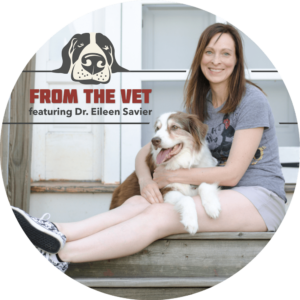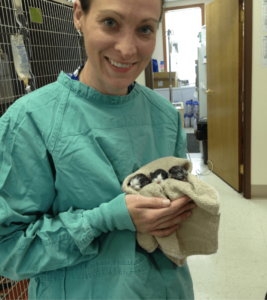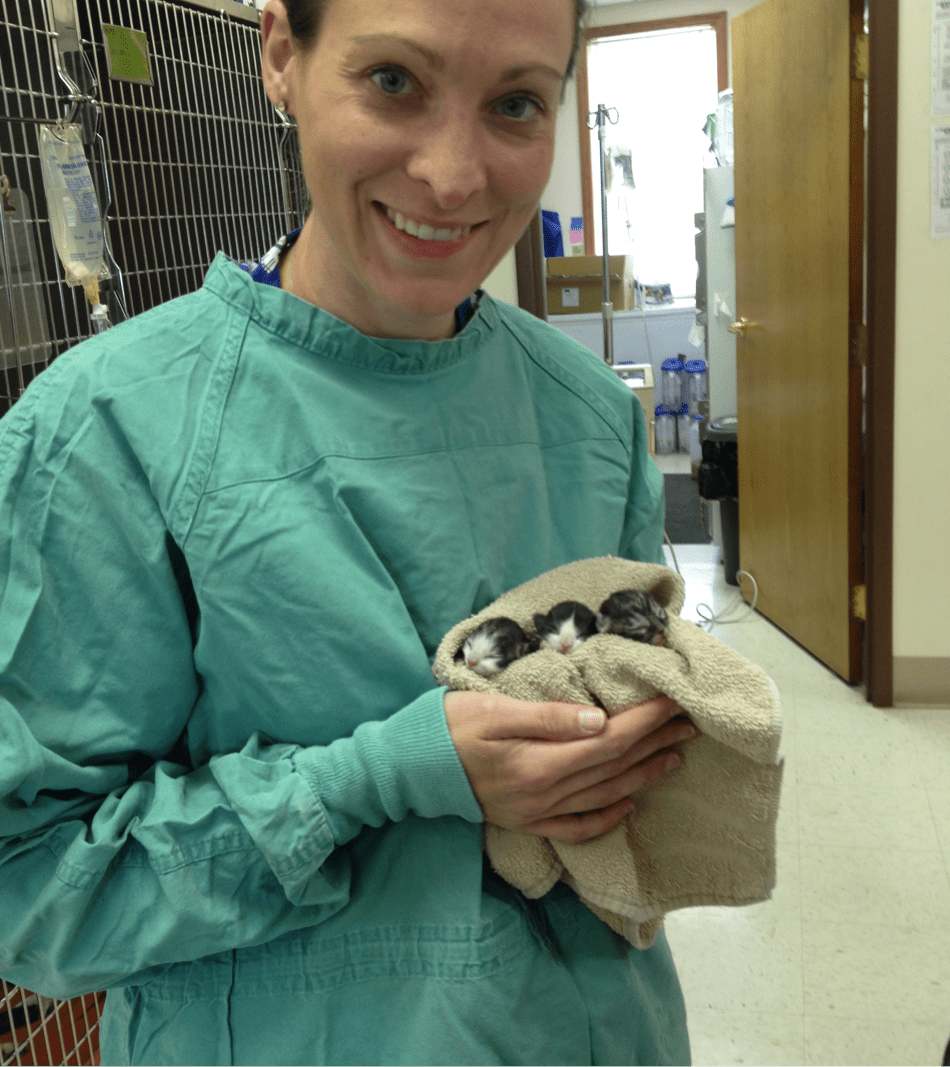[vc_row][vc_column][trx_section box=”yes”][trx_title align=”center” color=”#d9ae4c” weight=”700″]
From the Trenches
[/trx_title][trx_title align=”center” color=”#d9ae4c” weight=”700″]
A Vet’s Story
[/trx_title][trx_title type=”4″ align=”center” color=”#434544″ weight=”700″ bottom=”mini”]by Dr. Eileen Savier CVA, CVCH[/trx_title][vc_column_text]

He is Acting Fine…But Won’t Eat
Herby is a middle aged sheepdog that woke up one and was refusing to eat his food. No vomiting or diarrhea – just would NOT eat. His owners tried everything to get him to eat – new food, treats, people food – you name it or think of it, they tried it. On physical exam, Herby had lost 15% of his body weight in just a few short weeks. Otherwise, his exam was unremarkable and nothing appeared to be wrong. We start with baseline lab work – normal. We took x-rays – normal. Gastrointestinal panel, fecal, urinalysis – yep, all normal. CRAP! Not only have we now spent hundreds of dollars, but we are still no closer to a diagnosis. This scenario is not only frustrating (and scary) to Herby’s owner, but to me too! And, while we test, Herby is still wasting away – down another three pounds while we wait on test results. It was, at this time, that we discussed a trail of medications to see if Herby would start eating or if his owners would like to be referred to a specialist to try and get an answer for his weight loss and anorexia. His owners decided to consult with a specialist to get more information.
The specialist did an abdominal ultrasound – normal. The next step was to biopsy Herby’s intestines. There are two ways to collect biopsies – one is minimally invasive and one definitely NOT. However, with the minimally invasive method, samples collected are limited to stomach and top portion of the small intestine and are only partial thickness of the tissue. This technique does require anesthesia, but there is no incision into the abdomen. The second method is to take a pet to surgery and evaluate and sample major organs and all sections of the intestines – collecting full thickness biopsies. The risk of complication are higher, but you get better samples and you can evaluate organs and intestines. If anything looks abnormal during the surgery, you can immediately sample that area. Since this is a full abdominal surgery – recovery is 10-14 days.
Herby’s family decided to start with the minimally invasive surgery and collect as many samples as possible using that method. The samples showed evidence of Inflammatory Bowel Disease (IBD). This diagnosis was not a surprise and also not very helpful, because Herby was already on a prescription diet as IBD was a presumptive diagnosis for him several years previously.
At this time, the specialist decided to start over and take the case from the beginning – taking a detailed history of feeding, where and how his owners were purchasing food, how it was being stored, etc. At this time, it was suspected the storage and handling of the food was the problem Herby’s owners were buying large bags of prescription food from Chewy.com. When it arrived, they were transferring the food to a plastic storage container versus leaving it in the original packaging. This particular food was light sensitive so essentially the food was spoiling and Herby didn’t want to eat spoiled food. Upon closer inspection of the food – printed on the bag (near the perforated edge), it stated “store in original packaging”.
This is truly a learning experience for everyone involved in this case (and you can learn with us). I had never looked for how the company recommended storing the dog food. I had always bought the largest bag available (so I have to purchase less often and most of the time can save a little money too). I had always transferred the kibble into a large plastic storage bin. Also guilty – I had never cleaned the bin between bags of food – BUT NOW I DO. These are amazing pup owners – who like the rest of us – made a simple error that had some large implications.
Herby was put on a appetite stimulant for a short period of time and Herby’s owner bought smaller bags of his prescription diet and stored it accordingly to manufacturers’ instructions. Fast forward a month, and Herby is back to his healthy and normal self.
What a simple, but expensive lesson to learn for everyone – Dog’s, like humans, don’t like spoiled food and it will make them sick.
Check your kibble friends.[/vc_column_text][/trx_section][/vc_column][/vc_row][vc_row css=”.vc_custom_1533135180690{margin-top: 40px !important;}”][vc_column css=”.vc_custom_1533134942241{background-color: #d9ae4c !important;}”][trx_title type=”2″ align=”left” color=”#f6f2e4″ left=”20″ right=”20″]About Dr. Eileen Savier[/trx_title][vc_column_text css=”.vc_custom_1533135315368{padding-right: 20px !important;padding-bottom: 30px !important;padding-left: 20px !important;}”] Barks & Recreation is proud to feature Dr. Eileen Savier CVA, CVCH as our Veterinary Blogger in our “From the Vet” Series. Currently part of the team of doctors at Keystone Veterinary Clinic, Dr. Savier is a 2012 Graduate of the Ross University School of Veterinary Medicine, She completed her clinical experience at The Ohio State University and after veterinary school she pursued further education and certification in Veterinary Acupuncture, Chinese Herbal Medicine, and Fear Free veterinary visits. Dr. Savier has a special interest in integrative medicine, animal behavior, and internal medicine and is committed to improving animal health care by integrating Eastern and Western philosophies. She enjoys working with fearful & aggressive dogs and cats and she has had additional training in low stress handling techniques and encourages positive reinforcement during exams and procedures. Her clinical interests include pain management, animal behavior, geriatric patient care, and internal medicine. Dr. Savier is a member of the following associations:
Barks & Recreation is proud to feature Dr. Eileen Savier CVA, CVCH as our Veterinary Blogger in our “From the Vet” Series. Currently part of the team of doctors at Keystone Veterinary Clinic, Dr. Savier is a 2012 Graduate of the Ross University School of Veterinary Medicine, She completed her clinical experience at The Ohio State University and after veterinary school she pursued further education and certification in Veterinary Acupuncture, Chinese Herbal Medicine, and Fear Free veterinary visits. Dr. Savier has a special interest in integrative medicine, animal behavior, and internal medicine and is committed to improving animal health care by integrating Eastern and Western philosophies. She enjoys working with fearful & aggressive dogs and cats and she has had additional training in low stress handling techniques and encourages positive reinforcement during exams and procedures. Her clinical interests include pain management, animal behavior, geriatric patient care, and internal medicine. Dr. Savier is a member of the following associations:
- American Veterinary Medical Association (AVMA)
- International Veterinary Academy of Pain Management (IVAPM)
- American Association of Feline Practitioners (AAFP)
- American Veterinary Society of Animal Behavior (AVSAB)
- American Association of Traditional Chinese Veterinary Medicine (AATCVM)
- Ohio Veterinary Medical Association (OVMA)
Dr. Savier shares her home with two (soon to be three) dogs, two cats, and a toddler. She lovingly refers to her two dogs as Coconut Retrievers as they were rescue dogs she brought home from the island of St. Kitts. In her free time she enjoys spending time with her family, going to the beach, and planning her next Disney vacation.
Join us every month for Dr. Savier’s “From the Vet” series to get more information related to the health and welfare of your furry family members![/vc_column_text][/vc_column][/vc_row]

 Barks & Recreation is proud to feature Dr. Eileen Savier CVA, CVCH as our Veterinary Blogger in our “From the Vet” Series — offering information related to the health and welfare of your furry family members! Currently part of the team of doctors at Keystone Veterinary Clinic, Dr. Savier is a 2012 Graduate of the Ross University School of Veterinary Medicine, She completed her clinical experience at The Ohio State University and after veterinary school she pursued further education and certification in Veterinary Acupuncture, Chinese Herbal Medicine, and Fear Free veterinary visits. Dr. Savier has a special interest in integrative medicine, animal behavior, and internal medicine and is committed to improving animal health care by integrating Eastern and Western philosophies. She enjoys working with fearful & aggressive dogs and cats and she has had additional training in low stress handling techniques and encourages positive reinforcement during exams and procedures. Her clinical interests include pain management, animal behavior, geriatric patient care, and internal medicine.
Barks & Recreation is proud to feature Dr. Eileen Savier CVA, CVCH as our Veterinary Blogger in our “From the Vet” Series — offering information related to the health and welfare of your furry family members! Currently part of the team of doctors at Keystone Veterinary Clinic, Dr. Savier is a 2012 Graduate of the Ross University School of Veterinary Medicine, She completed her clinical experience at The Ohio State University and after veterinary school she pursued further education and certification in Veterinary Acupuncture, Chinese Herbal Medicine, and Fear Free veterinary visits. Dr. Savier has a special interest in integrative medicine, animal behavior, and internal medicine and is committed to improving animal health care by integrating Eastern and Western philosophies. She enjoys working with fearful & aggressive dogs and cats and she has had additional training in low stress handling techniques and encourages positive reinforcement during exams and procedures. Her clinical interests include pain management, animal behavior, geriatric patient care, and internal medicine. Dr. Savier shares her home with two (soon to be three) dogs, two cats, and a toddler. She lovingly refers to her two dogs as Coconut Retrievers as they were rescue dogs she brought home from the island of St. Kitts. In her free time she enjoys spending time with her family, going to the beach, and planning her next Disney vacation.
Dr. Savier shares her home with two (soon to be three) dogs, two cats, and a toddler. She lovingly refers to her two dogs as Coconut Retrievers as they were rescue dogs she brought home from the island of St. Kitts. In her free time she enjoys spending time with her family, going to the beach, and planning her next Disney vacation.




